warning SKODA SUPERB 2004 1.G / (B5/3U) Workshop Manual
[x] Cancel search | Manufacturer: SKODA, Model Year: 2004, Model line: SUPERB, Model: SKODA SUPERB 2004 1.G / (B5/3U)Pages: 270
Page 80 of 270
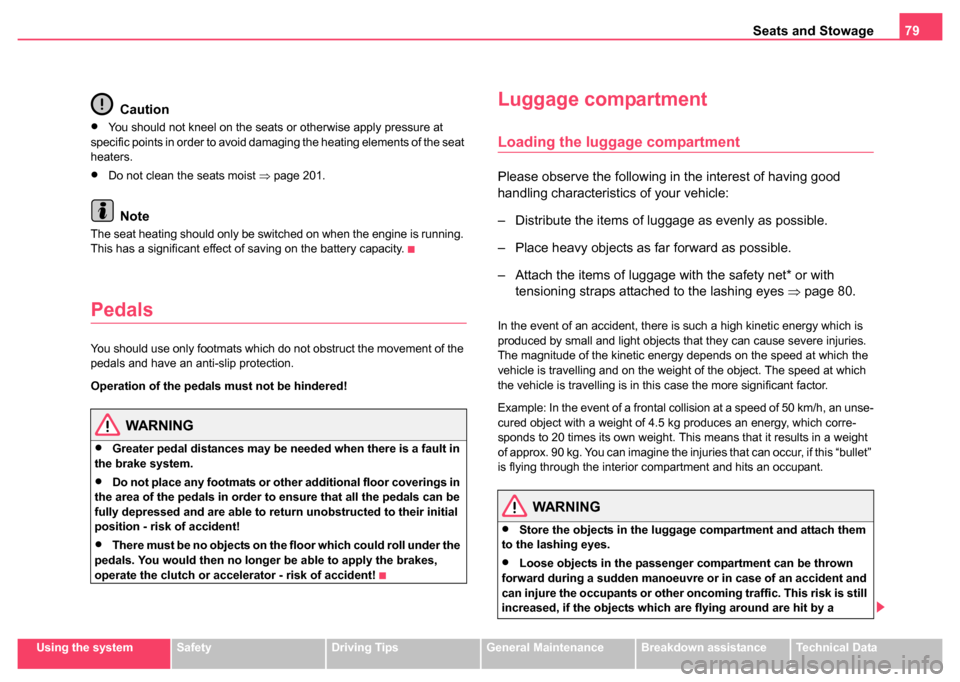
Seats and Stowage79
Using the systemSafetyDriving TipsGeneral MaintenanceBreakdown assistanceTechnical Data
Caution
•You should not kneel on the seats or otherwise apply pressure at
specific points in order to avoid damaging the heating elements of the seat
heaters.
•Do not clean the seats moist ⇒page 201.
Note
The seat heating should only be switched on when the engine is running.
This has a significant effect of saving on the battery capacity.
Pedals
You should use only footmats which do not obstruct the movement of the
pedals and have an anti-slip protection.
Operation of the pedals must not be hindered!
WARNING
•Greater pedal distances may be needed when there is a fault in
the brake system.
•Do not place any footmats or other additional floor coverings in
the area of the pedals in order to ensure that all the pedals can be
fully depressed and are able to return unobstructed to their initial
position - risk of accident!
•There must be no objects on the floor which could roll under the
pedals. You would then no longer be able to apply the brakes,
operate the clutch or accelerator - risk of accident!
Luggage compartment
Loading the luggage compartment
Please observe the following in the interest of having good
handling characteristics of your vehicle:
– Distribute the items of luggage as evenly as possible.
– Place heavy objects as far forward as possible.
– Attach the items of luggage with the safety net* or with tensioning straps attached to the lashing eyes ⇒page 80.
In the event of an accident, there is such a high kinetic energy which is
produced by small and light objects that they can cause severe injuries.
The magnitude of the kinetic energy depends on the speed at which the
vehicle is travelling and on the weight of the object. The speed at which
the vehicle is travelling is in this case the more significant factor.
Example: In the event of a frontal collision at a speed of 50 km/h, an unse-
cured object with a weight of 4.5 kg produces an energy, which corre-
sponds to 20 times its own weight. This means that it results in a weight
of approx. 90 kg. You can imagine the injuries that can occur, if this “bullet”
is flying through the interior compartment and hits an occupant.
WARNING
•Store the objects in the luggage compartment and attach them
to the lashing eyes.
•Loose objects in the passenger compartment can be thrown
forward during a sudden manoeuvre or in case of an accident and
can injure the occupants or other onc oming traffic. This risk is still
increased, if the objects which are flying around are hit by a
Page 81 of 270
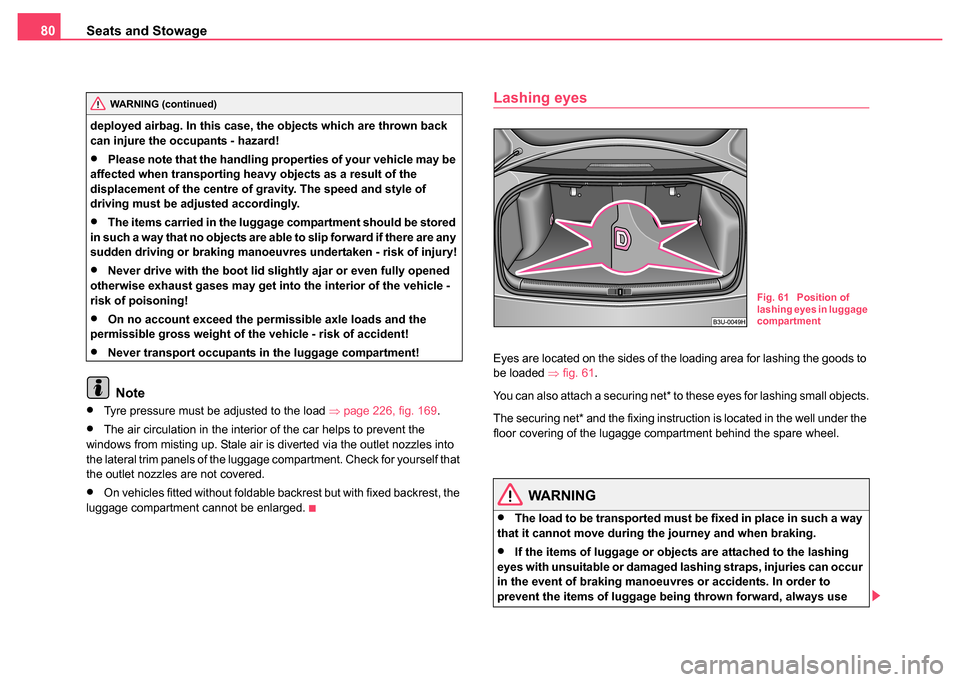
Seats and Stowage
80
deployed airbag. In this case, the objects which are thrown back
can injure the occupants - hazard!
•Please note that the handling properties of your vehicle may be
affected when transporting heavy objects as a result of the
displacement of the centre of gravity. The speed and style of
driving must be adjusted accordingly.
•The items carried in the luggage compartment should be stored
in such a way that no objects are able to slip forward if there are any
sudden driving or braking manoeuvres undertaken - risk of injury!
•Never drive with the boot lid slightly ajar or even fully opened
otherwise exhaust gases may get into the interior of the vehicle -
risk of poisoning!
•On no account exceed the permissible axle loads and the
permissible gross weight of the vehicle - risk of accident!
•Never transport occupants in the luggage compartment!
Note
•Tyre pressure must be adjusted to the load ⇒page 226, fig. 169 .
•The air circulation in the interior of the car helps to prevent the
windows from misting up. Stale air is diverted via the outlet nozzles into
the lateral trim panels of the luggage compartment. Check for yourself that
the outlet nozzles are not covered.
•On vehicles fitted without foldable backrest but with fixed backrest, the
luggage compartment cannot be enlarged.
Lashing eyes
Eyes are located on the sides of the loading area for lashing the goods to
be loaded ⇒fig. 61 .
You can also attach a securing net* to these eyes for lashing small objects.
The securing net* and the fixing instruction is located in the well under the
floor covering of the lugagge compartment behind the spare wheel.
WARNING
•The load to be transported must be fixed in place in such a way
that it cannot move during the journey and when braking.
•If the items of luggage or objects are attached to the lashing
eyes with unsuitable or damaged lashing straps, injuries can occur
in the event of braking manoeuvres or accidents. In order to
prevent the items of luggage being thrown forward, always use
WARNING (continued)
Fig. 61 Position of
lashing eyes in luggage
compartment
Page 82 of 270
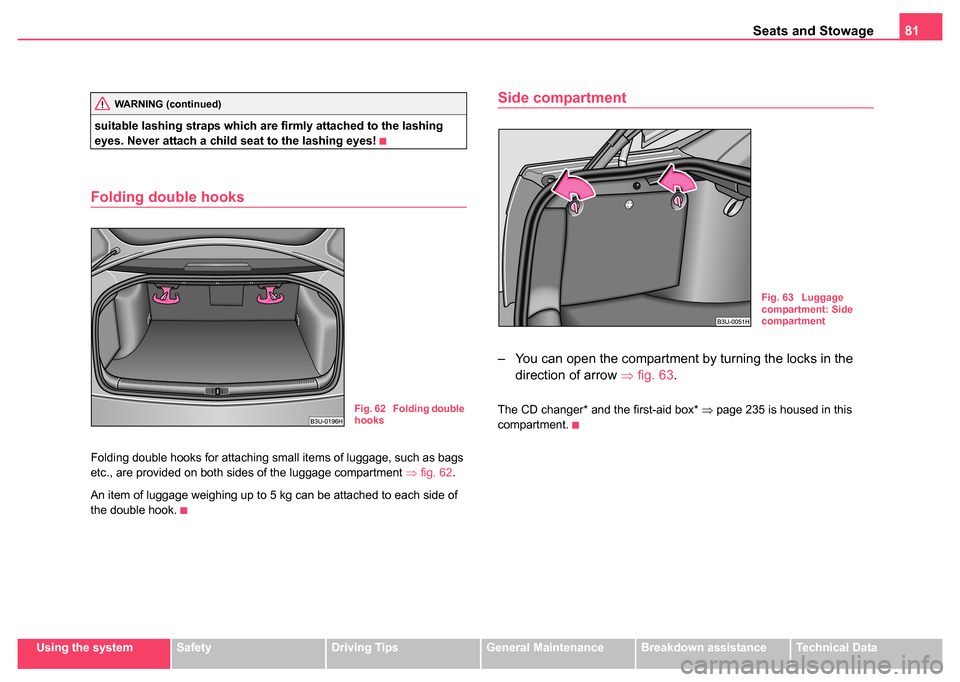
Seats and Stowage81
Using the systemSafetyDriving TipsGeneral MaintenanceBreakdown assistanceTechnical Data
suitable lashing straps which are
firmly attached to the lashing
eyes. Never attach a child seat to the lashing eyes!
Folding double hooks
Folding double hooks for attaching small items of luggage, such as bags
etc., are provided on both sides of the luggage compartment ⇒fig. 62 .
An item of luggage weighing up to 5 kg can be attached to each side of
the double hook.
Side compartment
– You can open the compartment by turning the locks in the direction of arrow ⇒fig. 63.
The CD changer* and the first-aid box* ⇒page 235 is housed in this
compartment.
WARNING (continued)
Fig. 62 Folding double
hooks
Fig. 63 Luggage
compartment: Side
compartment
Page 83 of 270
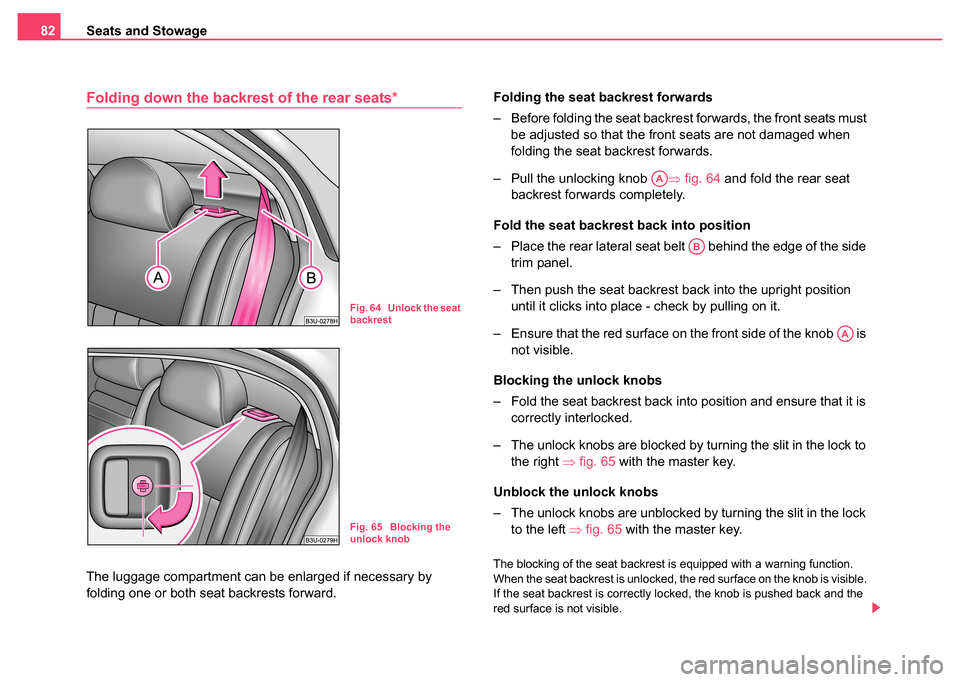
Seats and Stowage
82
Folding down the backr est of the rear seats*
The luggage compartment can be enlarged if necessary by
folding one or both seat backrests forward. Folding the seat
backrest forwards
– Before folding the seat backrest forwards, the front seats must be adjusted so that the front seats are not damaged when
folding the seat backrest forwards.
– Pull the unlocking knob ⇒fig. 64 and fold the rear seat
backrest forwards completely.
Fold the seat backrest back into position
– Place the rear lateral seat belt behind the edge of the side trim panel.
– Then push the seat backrest back into the upright position until it clicks into place - check by pulling on it.
– Ensure that the red surface on the front side of the knob is not visible.
Blocking the unlock knobs
– Fold the seat backrest back into position and ensure that it is correctly interlocked.
– The unlock knobs are blocked by turning the slit in the lock to the right ⇒fig. 65 with the master key.
Unblock the unlock knobs
– The unlock knobs are unblocked by turning the slit in the lock to the left ⇒fig. 65 with the master key. The blocking of the seat backrest is equipped with a warning function.
When the seat backrest is unlocked, the red surface on the knob is visible.
If the seat backrest is correctly locked, the knob is pushed back and the
red surface is not visible.
Fig. 64 Unlock the seat
backrest
Fig. 65 Blocking the
unlock knob
AA
AB
AA
Page 84 of 270
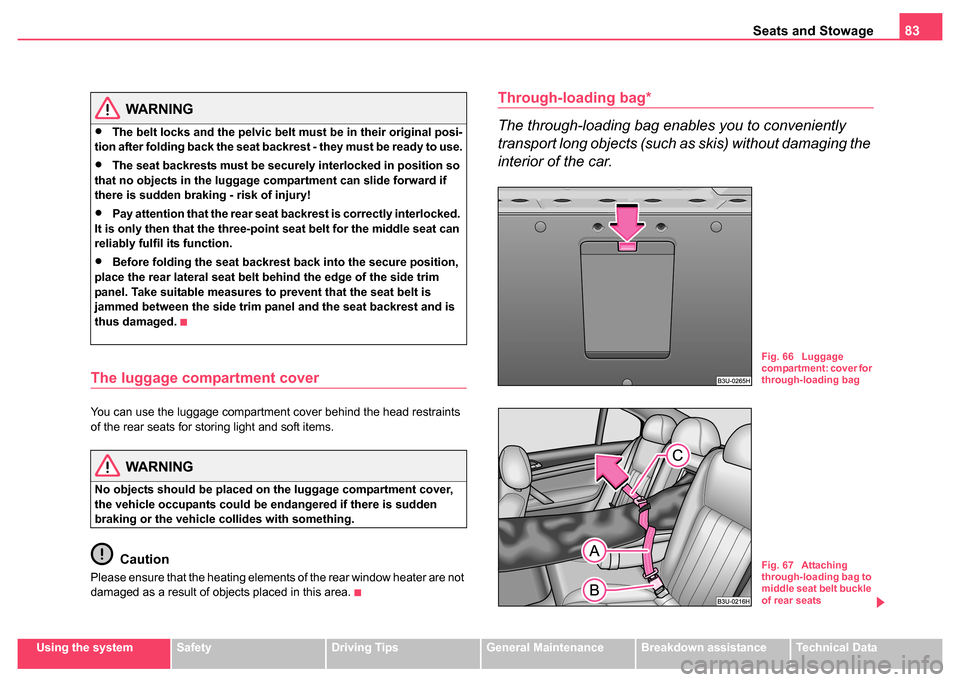
Seats and Stowage83
Using the systemSafetyDriving TipsGeneral MaintenanceBreakdown assistanceTechnical Data
WARNING
•The belt locks and the pelvic belt must be in their original posi-
tion after folding back the seat backrest - they must be ready to use.
•The seat backrests must be securely interlocked in position so
that no objects in the luggage compartment can slide forward if
there is sudden braking - risk of injury!
•Pay attention that the rear seat backrest is correctly interlocked.
It is only then that the three-point seat belt for the middle seat can
reliably fulfil its function.
•Before folding the seat backrest back into the secure position,
place the rear lateral seat belt behind the edge of the side trim
panel. Take suitable measures to prevent that the seat belt is
jammed between the side trim panel and the seat backrest and is
thus damaged.
The luggage compartment cover
You can use the luggage compartment cover behind the head restraints
of the rear seats for storing light and soft items.
WARNING
No objects should be placed on the luggage compartment cover,
the vehicle occupants could be endangered if there is sudden
braking or the vehicle co llides with something.
Caution
Please ensure that the heating elements of the rear window heater are not
damaged as a result of objects placed in this area.
Through-loading bag*
The through-loading bag enables you to conveniently
transport long objects (such as skis) without damaging the
interior of the car.
Fig. 66 Luggage
compartment: cover for
through-loading bag
Fig. 67 Attaching
through-loading bag to
middle seat belt buckle
of rear seats
Page 85 of 270
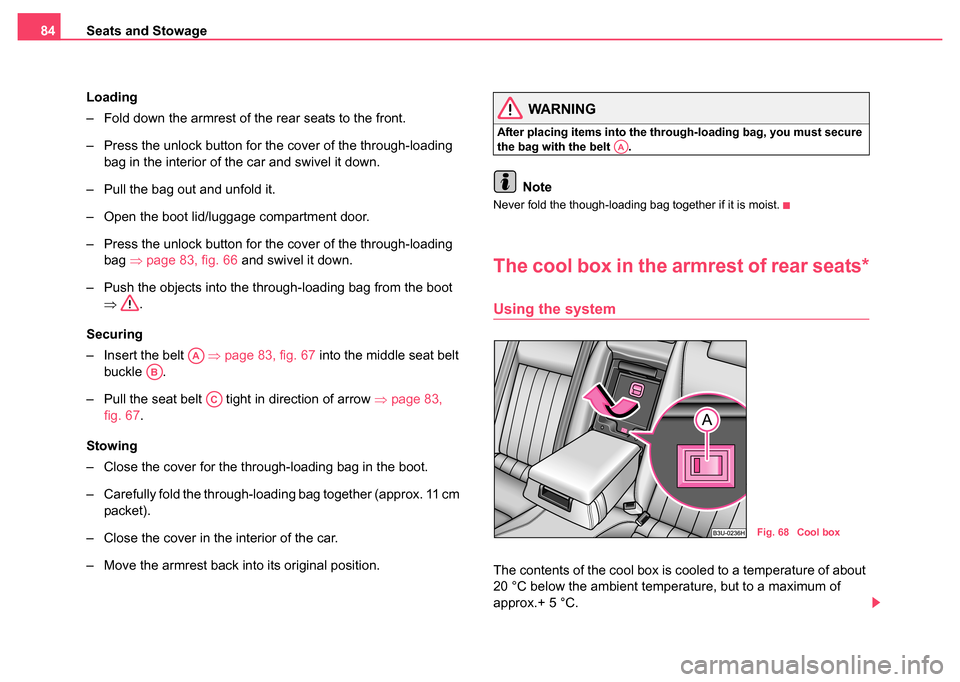
Seats and Stowage
84
Loading
– Fold down the armrest of the rear seats to the front.
– Press the unlock button for the cover of the through-loading bag in the interior of the car and swivel it down.
– Pull the bag out and unfold it.
– Open the boot lid/luggage compartment door.
– Press the unlock button for the cover of the through-loading bag ⇒page 83, fig. 66 and swivel it down.
– Push the objects into the through-loading bag from the boot ⇒ .
Securing
– Insert the belt ⇒page 83, fig. 67 into the middle seat belt
buckle .
– Pull the seat belt tight in direction of arrow ⇒page 83,
fig. 67.
Stowing
– Close the cover for the through-loading bag in the boot.
– Carefully fold the through-loading bag together (approx. 11 cm packet).
– Close the cover in the interior of the car.
– Move the armrest back into its original position.
WARNING
After placing items into the through-loading bag, you must secure
the bag with the belt .
Note
Never fold the though-loading bag together if it is moist.
The cool box in the armrest of rear seats*
Using the system
The contents of the cool box is cooled to a temperature of about
20 °C below the ambient temperature, but to a maximum of
approx.+ 5 °C.
AA
AB
AC
AA
Fig. 68 Cool box
Page 92 of 270
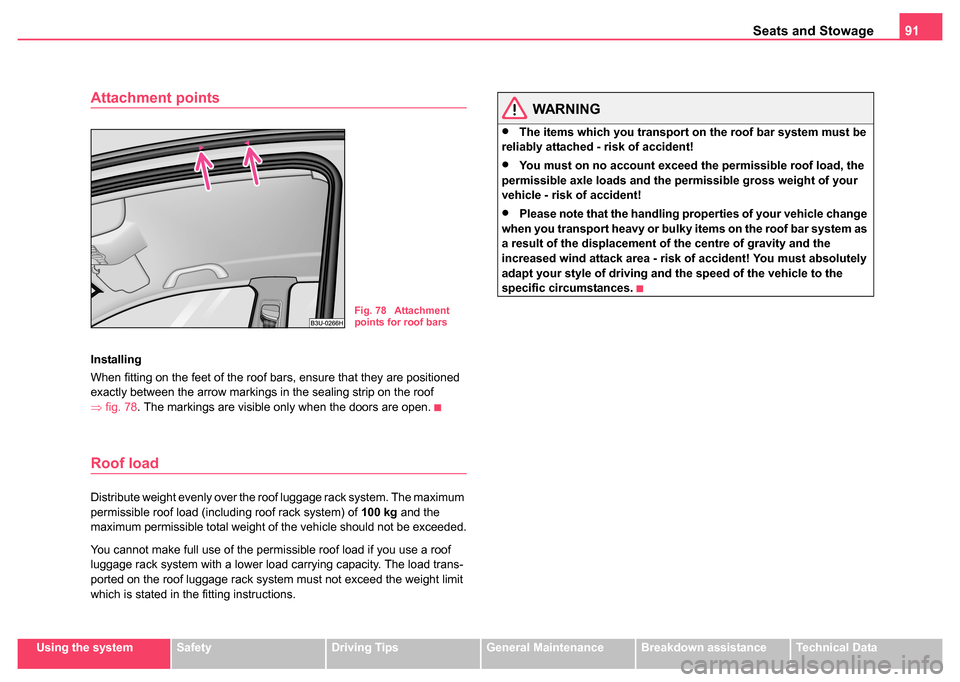
Seats and Stowage91
Using the systemSafetyDriving TipsGeneral MaintenanceBreakdown assistanceTechnical Data
Attachment points
Installing
When fitting on the feet of the roof bars, ensure that they are positioned
exactly between the arrow markings in the sealing strip on the roof
⇒fig. 78 . The markings are visible only when the doors are open.
Roof load
Distribute weight evenly over the roof luggage rack system. The maximum
permissible roof load (including roof rack system) of 100 kg and the
maximum permissible total weight of the vehicle should not be exceeded.
You cannot make full use of the permissible roof load if you use a roof
luggage rack system with a lower load carrying capacity. The load trans-
ported on the roof luggage rack system must not exceed the weight limit
which is stated in the fitting instructions.
WARNING
•The items which you transport on the roof bar system must be
reliably attached - risk of accident!
•You must on no account exceed the permissible roof load, the
permissible axle loads and the permissible gross weight of your
vehicle - risk of accident!
•Please note that the handling properties of your vehicle change
when you transport heavy or bulky items on the roof bar system as
a result of the displacement of the centre of gravity and the
increased wind attack area - risk of accident! You must absolutely
adapt your style of driving and the speed of the vehicle to the
specific circumstances.
Fig. 78 Attachment
points for roof bars
Page 93 of 270

Seats and Stowage
92
Drinks can holder
Drinks can holder in centre console
You can place two cups or beverage cans into the recesses ⇒fig. 79 .
WARNING
•Do not place any hot beverages into the can holder while the car
is moving. The hot beverages may spill - risk of scalding!
•Do not use any cups or beakers which are made of hard or brittle
material (e.g. glass, porcelain). You might be injured by them in the
event of an accident!
Drinks can holder in armrest of the rear seats
The drinks can holder is provided in the stowage compartment.
Access to drinks can holder
– Raise the cover of the armrest.
– You can take off the drinks can holder. Unlock it ⇒fig. 80 and
attach it to the cover of the armrest.
Only place cans into the drinks can holder which are held tight in the
holder.
It is possible to place up to two beverage cans in the drinks can holder of
the armrest.
Fig. 79 Centre
console: Drinks can
holder
Fig. 80 Drinks can
holder in rear armrest
Page 94 of 270

Seats and Stowage93
Using the systemSafetyDriving TipsGeneral MaintenanceBreakdown assistanceTechnical Data
WARNING
•Do not place any hot beverages into the can holder while the car
is moving. The hot beverages may spill - risk of scalding!
•Do not use any cups or beakers which are made of hard or brittle
material (e.g. glass, porcelain). You might be injured by them in the
event of an accident!
Ashtray
Ashtray at the front
Opening ashtray
– Press on the bottom part of the cover of the ashtray - refer to ⇒ fig. 81. Removing the ashtray insert
– Grasp the ashtray insert ⇒
fig. 81 at the side recesses and
pull it out.
Replacing the ashtray insert
– Press the ashtray insert into the mount.
WARNING
Never lay flammable objects in the ashtray basin - risk of fire!
Ashtray at the rear*
Opening ashtray
– Press on the top part of the cover of the ashtray.
Fig. 81 Centre
console: opened
ashtray
AA
AB
Fig. 82 Ashtray at the
rear
Page 95 of 270

Seats and Stowage
94
Removing the ashtray insert
– Press the cover of the ashtray down slightly as far as the stop.
– Grasp the ashtray insert and pull it out at an angle of about 45°.
Replacing the ashtray insert
– Position the ashtray insert at an angle of about 45° and press it into the mount as far the stop.
WARNING
Never lay flammable objects in the ashtray basin - risk of fire!
Ashtray in the armrest*
Ashtray located in the armrest of the rear right door
Opening ashtray
– Press on the middle part of the cover of the ashtray.
Removing the ashtray insert
– Press on the top part of the opened ashtray in position , the ashtray insert is raised ⇒fig. 83 .
Replacing the ashtray insert
– Press the ashtray insert into the armrest.
WARNING
Never lay flammable objects in the ashtray basin - risk of fire!
Fig. 83 Ashtray in the
armrest of the rear right
door
AA
AB